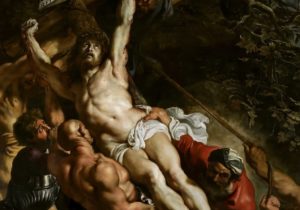How should we think about the insurrectionists of January 6, 2021? Although months have passed, in many cases the analysis of these people’s motives and ideologies has been shallow. Popular media highlights the outlandish garb of the “QAnon Shaman” and calls out the stupidity of livestreaming a storming of the US Capitol. Many nominal evangelicals with varying levels of connection to a local church have fallen down the rabbit hole of conspiracy theories that form the conspiracy-believer collective “QAnon.” This analysis is barely illuminating and hardly entertaining.
But the January Insurrection presses a question to the church that has grown louder and louder since the beginning of the Trump fiasco: Is this biblical politics? If not, what is this?
To give away the answer, I do not think this QAnon conspiracy politics is the most faithfully Christian approach to politics, nor do I think this is the end result of a doggedly “biblical” political commitment. But it would be too easy to simply identify norm violations (disregard for Romans 13 comes to mind) and determine that “Christianity” and “evangelicalism” are mere veneers under which a more self-consistent, non-religious approach lurks. This would be convenient but would unfortunately be inaccurate and simplistic.
Instead, I want to illuminate this conspiratorial approach, which I term “Christian Virtual Reality Politics,” by contrasting it with a more familiar approach, which I call “Christian Religious Politics.” If my distinction is successful, the reader will be able to identify the ways Christianity the religion intersects and is distinguishable from either political paradigm.
“Christian Religious Politics” hopefully makes enough sense on its own. It distinguishes a certain approach to politics from an approach that Christians merely perform or that is responsive to Christian culture, but that the institutions and structures of religion do not substantively motivate or inform.
However, the moniker virtual reality is more obscure. This approach is thoroughly anti-foundationalist and social in its philosophy, and elevates cultural and technological embeddedness in internet society (e.g., forums, Facebook groups, sub-communities on Twitter and YouTube, etc.) above embeddedness in face-to-face social institutions. It is the intersection of postmodern epistemology with one of postmodernity’s most iconic social forms: the internet. This is a type of virtual reality because the means of knowledge and how truth is validated are both constructed through the lens of a virtual space (the internet) rather than in the context of first-order “reality.”
Of course, schemas like these, especially in the absence of hard sociological data, are of limited usefulness, and using them can veer into speculation and pontification. But I hope this discussion can help readers understand what’s happening. To get a few things out of the way: (1) I think that many different kinds of VR politics are operative in the world, (2) that this eventuality is not a consequence of the internet per se, and (3) that VR politics seem to be more powerful in the United States than in other places. I hope to touch on these points but will focus my efforts on elucidating a few of the Christian Virtual Reality Politics that manifested in some shocking ways in January. The rest of this article will focus on two of these features.
The first question is, as is so often the case, the question of truth: By what means may a person find out what is true in the world? Indeed, this is one of the fundamental problems of philosophy because it was first a fundamental answer of religion. The religious answer is that only revelation from above can provide the basis for truth. The Christian answer more specifically claims that the foundation of truth is found in God and the knowledge of that truth is from His gracious revelation. Since this Divine Truth is also the Creator God, we may hope that we can know the truth and that there are truths to be known about the created world.
On the other hand, we recognize ourselves as humble vessels. We misinterpret God’s truth, by sin and stupidity. The fact that we believe something does not make it truer; we trust that, by following after Jesus as we practice love for the truth, His Spirit will be faithful to lead us into all truth (John 16:13). By this, we can hold our beliefs tightly and hold the contribution of our powers of believing lightly at the same time. Consequently, when someone who practices Christian Religious Politics encounters opposition, their practice dictates both an element of resolute conviction and an element of self-reflection and humility. Together, these form the basis of serious disagreement and constructive dialogue.
By contrast, what makes the virtual reality approach distinct is its insensitivity to external truths. This family of reality-insensitive hermetic ideo-worldviews deduces truth from narrative coherence and existential acceptance. Let me unpack what I mean by that. The existential component is what makes the approach both dynamic (the self is the ultimate gatekeeper) and hermetic (there is no source of revelation to which the self is ultimately responsible, so the only network of truth is the one that is judged by the self to be in at least marginally superior harmony).
But Christian VR Politics is also hermetic in a very different sense: in its invitation to participate in cosmic forces. This is not only true for the January insurrectionists, but also of every member of QAnon who participates in forums that decipher and predict the next development. This is a “hyperstital” participation in the sense that the process of discovery is liminally related to the power of action. Just as speculation about the next season of a television show might influence the creative choices of the director, so the most invested participants might view themselves as actively uncovering the clues of the conspiracy and influencing real-world outcomes. Of course, as they participate, their world becomes increasingly focused on cooperating with others (at varying levels of belief) to unravel the mystery.
This points to another difference between Christian Religious Politics and Christian VR Politics. In the Christian VR Politics framework, going deeper down the rabbit hole delivers knowledge and thereby empowers participants. Through gateways of irony and curiosity, the individual may choose how much they want to understand by pursuing increasingly implausible and reality-divorced narratives of evidence. As in conspiratorial thought in general, those who do not believe are simply dupes, and their knowledge is functionally a piece of the grand illusion. Digging deeper into the logic of the conspiracy, the VR pilgrim is on a path to transcend the bonds of their ignorance and manipulation.
Christian Religious Politics has an element of this too. At root, there is a division between those who have the light of Christ and thereby have a way of reliably seeking truth in the world, and those who have not been so enlightened and thereby are easily deceived and tempted. But unlike the VR approach, Christian Religious Politics includes fundamentally universal constraints on and powers of knowing. All people, regardless of their belief in Christ, are made in the image of God and therefore are designed to apprehend truth. All people, including Christians, are fallen and thereby tempted to resist the truth even when we find it. Finally, all people of all kinds are part of the same world governed by the same God and revealed in the Savior of the entire creation.
These two features regarding the primary question of truth on the one hand and the constraints and powers of knowledge on the other hand should be enough to indicate the kind of phenomenon I am describing with Christian Virtual Reality Politics. It is a political approach that approaches Gnosticism in some curious ways. But as a reader, you may be wondering, How do these differences cash out in practice? How is it that such an idiosyncratic worldview nevertheless maintains a form of Christian-ness to it? I hope to address these and other questions in the follow-up to this article.





